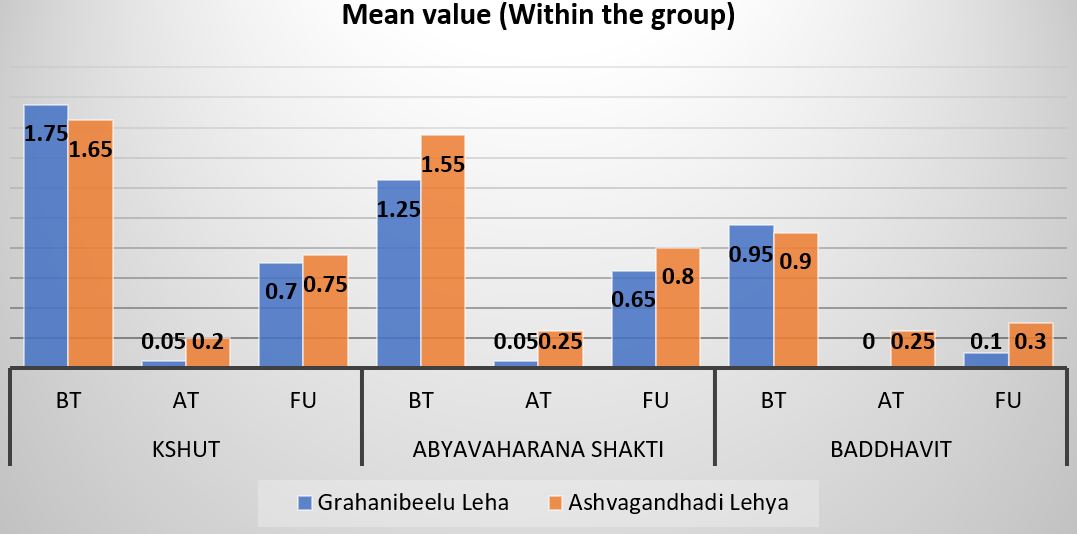A Randomized Comparative Clinical Study to Evaluate the effect of Grahanibeelu Leha (Leucas biflora [Vahl] R.Br.) and Ashvagandhadi Lehya in Karshya w.s.r. to Underweight in children
DOI:
https://doi.org/10.21760/jaims.10.7.7Keywords:
Karshya, Grahanibeelu Leha, Ashvagandhadi LehyaAbstract
Undernutrition is a growing concern, particularly in early childhood, significantly contributing to the morbidity and mortality of children, as countries navigate the challenges of economic growth, food insecurity, and changing dietary patterns. From an Ayurvedic perspective, under the umbrella of Kuposhanajanya Vyadhis (Under nutritional diseases), Underweight can be considered under Karshya (Underweight) which refers to a state of emaciation due to inadequate nourishment, which can be managed with nourishing therapies and formulations aimed at enhancing body tissue formation and strength. According to NFHS-4, 35.7% of children under five in India were underweight and comparing to recent data from NFHS-5 (2019-2021) indicate some progress but the problem remains severe in many regions. Hence it is necessary to address Karshya. The trial was proposed to study the comparative effect of Grahanibeelu Leha and Ashvagandhadi Lehya on specific parameters of Karshya w.s.r. to Underweight in children. Materials and Methods: 1. Children of age group 1-5 years of either gender, fulfilling the diagnostic criteria of Karshya (Underweight), with consent from the parents were selected from Kaumarabhritya OPD of Sri Dharmasthala Manjunatheshwara Ayurveda College, Hospital and Research Centre, Udupi. 2. Selected subjects will be randomly allocated into 2 groups of 20 patients each. Group A was administered with Grahanibeelu Leha and group B with Ashvagandhadi Lehya with Sukoshna Ksheera as Anupana for both the groups twice daily before food, intervention for 1 month and were assessed before and after treatment with subjective and objective criteria. Results: The results obtained were statistically analysed and found that, within the group, showed that highly significant improvement in Kshut, Weight and MAC & significant improvement in improving Abhyavaharana Shakti, Baddhavit and Height. However, in the comparative between both groups, Grahanibeelu Leha shows significant result in Abhyavaharana Shakti while other parameters (Kshut, Baddhavit, Weight, Height and MAC) were clinically effective but statistically insignificant. Conclusion: Both Grahanibeelu Leha and Ashvagandhadi Lehya along with Sukoshna Ksheera are safe and effective in the management of Karshya w.s.r. to underweight in children.
Downloads
References
Ghai OP. Essential pediatrics. 6th ed. New Delhi: CBS Publishers & Distributors; 2005. p.13,94.
Gune S, Avula R, Singh SK, Sarwal R, Bhatia N, Johnston R, et al. State nutrition profile: Karnataka. POSHAN Data Note 46. New Delhi: International Food Policy Research Institute; 2021.
Kori VK. Brimhana effect of Ashwagandha Kshira Basti in Krisha children. K.B. Dept.; 1999.
Global Hunger Index [Internet]. India: Global Hunger Index; [cited 2025 Jul 25]. Available from: https://www.globalhungerindex.org/india.html
Mayakar PI, Jartarghar NS, Ravikrishna S, Chithralekha. Grahanibeelu (Leucas biflora [Vahl] R. Br) an extra pharmacopeial drug of Ayurveda: an overview. Int J Res Ayurveda Pharm. 2023;14(2):173–5. doi:10.7897/2277-4343.140264
Lee DH, Ahn J, Jang YJ, Seo HD, Ha TY, Kim MJ, et al. Withania somnifera extract enhances energy expenditure via improving mitochondrial function in adipose tissue and skeletal muscle. Nutrients. 2020 Feb 7;12(2):431. doi:10.3390/nu12020431. PMID: 32046183; PMCID: PMC7071232
Leung AK, Marchand V, Sauve RS; Canadian Paediatric Society, Nutrition and Gastroenterology Committee. The 'picky eater': the toddler or preschooler who does not eat. Paediatr Child Health. 2012 Oct;17(8):455–60. doi:10.1093/pch/17.8.455. PMID: 24082809; PMCID: PMC3474391
Mayakar PI, Jartarghar NS, Ravikrishna S, Chithralekha. Preparation and physicochemical evaluation of Grahanibeelu Leha. Int J Ayu Pharma Chem. 2025;22(1):2350–0204.















